- Lieutenant John Bythesea, VC, R.N.
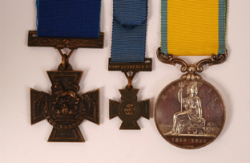
- Sergeant Bruce Ogden-Smith, DCM, MM
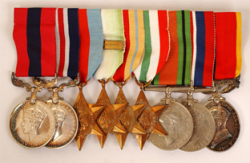
- Colour-Sergeant James Carnegie
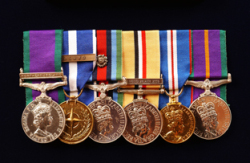
- Major John Potter, MC
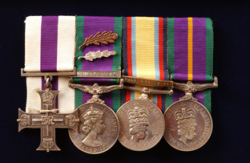
- Sergeant Barry Davies, BEM
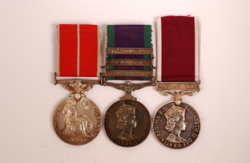
About the Ashcroft Collection
Special Forces Heroes is not intended to be a history of the British Special Forces – this has been achieved with great success by others. Neither is it meant to be the definitive book detailing all the heroes of Britain’s Special Forces over the years.
Instead, the book deals solely with the collection of gallantry medals Lord Ashcroft started to build up two decades ago and which were generally awarded to servicemen for Special Forces or Commando-style operations – even though some of the recipients were not members of the Special Air Service (SAS) or Special Boat Service (SBS).
Today these medals – which form the largest private collection of such British decorations in the world – are owned by a trust that was set up to care for and protect them. It is the same trust that is responsible for preserving the collection of Victoria Crosses – once again the largest in the world – that Lord Ashcroft first began to amass in 1986. This VC collection, incidentally, will go on public display in 2010 following a considerable donation by Lord Ashcroft to the opening of a new gallery at the Imperial War Museum London.
Lord Ashcroft’s first purchase of a medal for Commando or Special Forces type operations came in the summer of 1988 when he learnt that the medals of Corporal William ‘Bill’ Sparks were being auctioned at Sotheby’s. Sparks, a Royal Marine, was one of the famous ‘Cockleshell Heroes’ who had carried out a daring raid behind enemy lines in December 1942. Lord Ashcroft had been fascinated by the Cockleshell Heroes since he was a boy. He found it astonishing that a group of men had undertaken such a difficult and dangerous assignment when they knew there was an incredibly high chance they would either die or be captured. The Cockleshell Heroes and the Dambusters were two missions that had enthralled him as a boy. He had watched the film The Cockleshell Heroes – in all its black and white glory – shortly after it came out at the end of 1955 when he was just nine years old. He watched the film open-mouthed and at the end felt totally in awe of the bravery of those who had participated in the operation.
Twelve men headed off in a submarine and were then left to paddle up one of Occupied France’s largest estuaries in their small canoes with their faces blackened. Even before they set out, they were warned by their commanding officer – who had come up with the idea for the operation – that their own safety came second to the success of the mission. They were even told that if they succeeded in blowing up their targets – enemy ships – they would be on their own because it was too difficult and dangerous for anyone to come and fetch them. In short, they were told they should try to get from near Bordeaux in south-west France to Spain using their own initiative in an unfamiliar country swarming with German soldiers and their informants. Yet still these men – motivated by a desire to fight for their country, for freedom and for their comrades – unhesitatingly agreed to climb out of their submarine into canoes and embark on a mission which would cost eight of them their lives. Lord Ashcroft finds such raw courage utterly astonishing and deeply moving.
After he was the successful bidder for Sparks’ medals, Lord Ashcroft decided that he would occasionally expand his collection to include bravery medals in general – not just VCs. So now and again, when a medal with a fascinating story comes up – perhaps one with a quirk of history, an unusual location for a battle, an outstanding piece of team work or an incredible example of courage – then he bids for the medal. This buying process has generally accelerated over the years and he has developed a particular interest in Special Forces’ style operations. And so, one thing led to another, and now there is this second collection of gallantry and service medals, which is separate from the VC collection. Today the second collection involves the medals of more than 40 men.
History books rightly record that the immediate origins of the British Special Forces lie in the early years of the Second World War. Lord Ashcroft makes no apology, however, for applying the term and the title of the book – Special Forces Heroes – more loosely: to medals won for daring hit-and-run raids against a far bigger military force, for missions deep behind enemy lines and the like. He is therefore, in some cases, writing about incidents that go back to the mid 19th century, when some of the basic tactics later adopted by the SAS and the SBS were first used by British servicemen.
Lord Ashcroft has gone to great lengths not to reveal sensitive information about national security or to endanger the safety of individual former servicemen, notably those who operated in Northern Ireland. In some cases, he has changed the names of some of the men who featured in this book, either at their request or because he was unable to trace them and he did not want to risk their security. For security reasons, too, he has not given the dates of birth of men who served after the Second World War or the towns or villages in which they now live. Furthermore, in a small number of instances, he has chosen not to reveal the date the gallantry awards were ‘gazettted’, or an individual’s rank or regiment. This has, once again, been done so that there can be nothing that leads to them being identified. In short, Lord Ashcroft has erred on the side of caution on anything to do with personal safety, but without holding back from telling the men’s sensational stories.